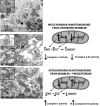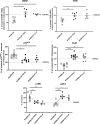Progesterone and Allopregnanolone Neuroprotective Effects in the Wobbler Mouse Model of Amyotrophic Lateral Sclerosis
- PMID: 34138412
- PMCID: PMC11441202
- DOI: 10.1007/s10571-021-01118-y
Progesterone and Allopregnanolone Neuroprotective Effects in the Wobbler Mouse Model of Amyotrophic Lateral Sclerosis
Abstract
Progesterone regulates a number of processes in neurons and glial cells not directly involved in reproduction or sex behavior. Several neuroprotective effects are better observed under pathological conditions, as shown in the Wobbler mouse model of amyotrophic laterals sclerosis (ALS). Wobbler mice are characterized by forelimb atrophy due to motoneuron degeneration in the spinal cord, and include microgliosis and astrogliosis. Here we summarized current evidence on progesterone reversal of Wobbler neuropathology. We demonstrated that progesterone decreased motoneuron vacuolization with preservation of mitochondrial respiratory complex I activity, decreased mitochondrial expression and activity of nitric oxide synthase, increased Mn-dependent superoxide dismutase, stimulated brain-derived neurotrophic factor, increased the cholinergic phenotype of motoneurons, and enhanced survival with a concomitant decrease of death-related pathways. Progesterone also showed differential effects on glial cells, including increased oligodendrocyte density and downregulation of astrogliosis and microgliosis. These changes associate with reduced anti-inflammatory markers. The enhanced neurochemical parameters were accompanied by longer survival and increased muscle strength in tests of motor behavior. Because progesterone is locally metabolized to allopregnanolone (ALLO) in nervous tissues, we also studied neuroprotection by this derivative. Treatment of Wobbler mice with ALLO decreased oxidative stress and glial pathology, increased motoneuron viability and clinical outcome in a progesterone-like manner, suggesting that ALLO could mediate some progesterone effects in the spinal cord. In conclusion, the beneficial effects observed in different parameters support the versatile properties of progesterone and ALLO in a mouse model of motoneuron degeneration. The studies foresee future therapeutic opportunities with neuroactive steroids for deadly diseases like ALS.
Keywords: Allopregnanolone; Amyotrophic lateral sclerosis; Neurodegeneration; Neuroprotection; Progesterone; Wobbler mouse.
© 2021. The Author(s), under exclusive licence to Springer Science+Business Media, LLC, part of Springer Nature.
Conflict of interest statement
The authors declare no conflict of interest.
Figures



Similar articles
-
Protective effects of the neurosteroid allopregnanolone in a mouse model of spontaneous motoneuron degeneration.J Steroid Biochem Mol Biol. 2017 Nov;174:201-216. doi: 10.1016/j.jsbmb.2017.09.015. Epub 2017 Sep 22. J Steroid Biochem Mol Biol. 2017. PMID: 28951257
-
Steroid Profiling in Male Wobbler Mouse, a Model of Amyotrophic Lateral Sclerosis.Endocrinology. 2016 Nov;157(11):4446-4460. doi: 10.1210/en.2016-1244. Epub 2016 Aug 29. Endocrinology. 2016. PMID: 27571131
-
Neuroprotective Effects of Testosterone in Male Wobbler Mouse, a Model of Amyotrophic Lateral Sclerosis.Mol Neurobiol. 2021 May;58(5):2088-2106. doi: 10.1007/s12035-020-02209-5. Epub 2021 Jan 7. Mol Neurobiol. 2021. PMID: 33411236
-
Cellular basis of steroid neuroprotection in the wobbler mouse, a genetic model of motoneuron disease.Cell Mol Neurobiol. 2001 Jun;21(3):237-54. doi: 10.1023/a:1010943104315. Cell Mol Neurobiol. 2001. PMID: 11569536 Free PMC article. Review.
-
Progesterone neuroprotection in traumatic CNS injury and motoneuron degeneration.Front Neuroendocrinol. 2009 Jul;30(2):173-87. doi: 10.1016/j.yfrne.2009.03.001. Epub 2009 Mar 24. Front Neuroendocrinol. 2009. PMID: 19318112 Review.
Cited by
-
Human Microglia Synthesize Neurosteroids to Cope with Rotenone-Induced Oxidative Stress.Antioxidants (Basel). 2023 Apr 19;12(4):963. doi: 10.3390/antiox12040963. Antioxidants (Basel). 2023. PMID: 37107338 Free PMC article.
-
Is Dutasteride a Therapeutic Alternative for Amyotrophic Lateral Sclerosis?Biomedicines. 2022 Aug 25;10(9):2084. doi: 10.3390/biomedicines10092084. Biomedicines. 2022. PMID: 36140184 Free PMC article. Review.
-
Functional Food Nutrients, Redox Resilience Signaling and Neurosteroids for Brain Health.Int J Mol Sci. 2024 Nov 12;25(22):12155. doi: 10.3390/ijms252212155. Int J Mol Sci. 2024. PMID: 39596221 Free PMC article. Review.
-
Genome-Wide Gene-Set Analysis Identifies Molecular Mechanisms Associated with ALS.Int J Mol Sci. 2023 Feb 16;24(4):4021. doi: 10.3390/ijms24044021. Int J Mol Sci. 2023. PMID: 36835433 Free PMC article.
-
Translocator Protein Ligand PIGA1138 Reduces Disease Symptoms and Severity in Experimental Autoimmune Encephalomyelitis Model of Primary Progressive Multiple Sclerosis.Mol Neurobiol. 2022 Mar;59(3):1744-1765. doi: 10.1007/s12035-022-02737-2. Epub 2022 Jan 11. Mol Neurobiol. 2022. PMID: 35018577
References
-
- Amengual-Gual M, Sanchez Fernandez I, Wainwright MS (2019) Novel drugs and early polypharmacotherapy in status epilepticus. Seizure 68:79–88. 10.1016/j.seizure.2018.08.004 - PubMed
-
- Aryanpour R, Pasbakhsh P, Zibara K, Namjoo Z, Beigi Boroujeni F, Shahbeigi S, Kashani IR, Beyer C, Zendehdel A (2017) Progesterone therapy induces an M1 to M2 switch in microglia phenotype and suppresses NLRP3 inflammasome in a cuprizone-induced demyelination mouse model. Int Immunopharmacol 51:131–139. 10.1016/j.intimp.2017.08.007 - PubMed
-
- Baulieu EE (1997) Neurosteroids: of the nervous system, by the nervous system, for the nervous system. Rec Prog Horm Res 52:1–32 - PubMed
-
- Beato M (1989) Gene regulation by steroid hormones. Cell 56(3):335–344. 10.1016/0092-8674(89)90237-7 - PubMed
-
- Belelli D, Lambert JJ (2005) Neurosteroids: endogenous regulators of the GABA(A) receptor. Nat Revi Neurosci 6(7):565–575. 10.1038/nrn1703 - PubMed
Publication types
MeSH terms
Substances
Grants and funding
LinkOut - more resources
Full Text Sources
Medical
Miscellaneous

